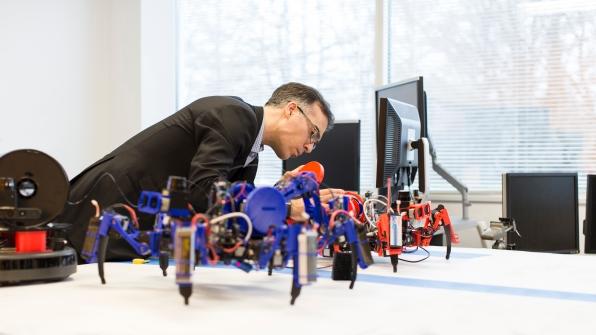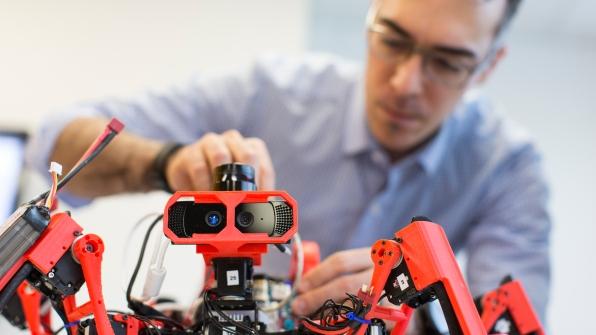Siemens: 3D Printing Spider Bots are Able to Collaborate in Smart Printing Teams, Covering Ground Autonomously
 While arachnophobia may invoke the unrealistic yet all too common fear and anticipation of hordes of black, hairy, killer spiders, the world may soon have a new take on the eight-legged creatures—and it’s a much kinder one as we see them working for us rather than creeping in the shadows and launching those surprise attacks we fear when we are helpless in the middle of the night.
While arachnophobia may invoke the unrealistic yet all too common fear and anticipation of hordes of black, hairy, killer spiders, the world may soon have a new take on the eight-legged creatures—and it’s a much kinder one as we see them working for us rather than creeping in the shadows and launching those surprise attacks we fear when we are helpless in the middle of the night.
Researchers at Siemens in Princeton, NJ don’t seem to be afraid of spiders at all—not even the larger ones roaming their facility; indeed, they are embracing the creatures in virtual reality form, working to imbue their robots with artificial intelligence that will allow them to work in teams and effectively create the first revolutionary trend in mobile manufacturing.
These prototypes may surprise many, as rather than spinning webs in corners and working to trap flies, they will be employed as industrial workers responsible for 3D printing structures as teams. The researchers have set their sights on industries like marine and aerospace, with these spiders to be happily welcomed into work areas as potential plane and boat builders, responsible for the construction of integral parts like fuselages and hulls.
This project, being led by Livio Dalloro from the Product Design, Modeling and Simulation Research group in the Automation and Control Technology Field at Siemens Corporate Technology (CT), is yet another case where we see new technology being created by scientists who in their respect for and observations regarding nature are able to come up with some incredible innovation. While previously we’ve reported on everything from 3D printed bionic ants to cocoon-inspired resin spinning, we’ve yet to see nature morphed into real working armies.
Now, the scientists from Siemens are reaching toward a vision of hundreds of these robotic spiders, referred to as SiSpis or Siemens Spiders, 3D printing large-scale items obediently.
“SiSpis are part of a larger picture that we define as Siemens Agile Manufacturing Systems (SiAMS) and they represent the core of our autonomous systems research here in Princeton,” says Dalloro, who explains that the spider-like bots are essentially fully autonomous additive manufacturing devices with legs. “We are looking at using multiple autonomous robots for collaborative additive manufacturing of structures, such as car bodies, the hulls of ships and airplane fuselages.”
While definitely reminiscent of rows and rows of dramatic sci-fi slaves pounding to a monotone beat, this futuristic workforce is envisioned as an autonomous one, used to print layers of materials in required areas via hundreds of bots each responsible for his own patch of labor. This idea for a veritable army of bots was developed through algorithms that would actually allow the spider bots to collaborate, truly creating a force working through teamwork.
“Each spider is capable of manufacturing only a small portion of a work piece,” explains Hasan Sinan Bank, a leader in the project as well who is also responsible for filing multiple associated patents. “We are therefore trying to conceptualize and optimize the kinds of collaboration these robots should engage in.”
If the idea of 3D printing in itself wasn’t astounding enough on its own, with this evolution of technology through the team at Princeton, we see the concept of multi-printers in a rather alternative form employing sub-technology during the process such as cameras and scanners. According to the researchers who have been working on this project since 2014, those items will work to help them ‘to interpret their immediate environment.’
 The bots can be tidily designated into their respective labor areas, calculated by the range of their ‘arms,’ which are in essence the extruders. The scientists see each work areas as being separated into vertical boxes, but with the potential for the spider bots to handle complicated geometries too—and comprehensively.
The bots can be tidily designated into their respective labor areas, calculated by the range of their ‘arms,’ which are in essence the extruders. The scientists see each work areas as being separated into vertical boxes, but with the potential for the spider bots to handle complicated geometries too—and comprehensively.
Being able to operate on their own is central to this concept. As they are aware of their location and even able to navigate around obstacles, when batteries are low they will actually be expected to make their way back to charging stations. No one will leave their ‘posts,’ though, without first letting the others know where they are going so that work continues seamlessly, and another spider picking up where the one with a low battery stops. The project is incredibly unique:
“Its goal,” says Dalloro, “was to create a prototype platform for autonomous manufacturing machines that can understand a task, split it up among available robots, and enter into a manufacturing process in a collaborative and coordinated way without explicit programming.”
“With the exception of the spiders’ mini motors and cables, which were off-the-shelf products, we developed everything ourselves from the mechanics to the software,” says Dalloro.
 Not only did the team create their own hybrid software solution, used in collaboration with NX, a software solution from Siemens, but they also made each spider component via 3D printing. Along with that, they also created ‘behavior’ for the robots:
Not only did the team create their own hybrid software solution, used in collaboration with NX, a software solution from Siemens, but they also made each spider component via 3D printing. Along with that, they also created ‘behavior’ for the robots:
“To do that,” says Bank, “we had to develop software tools to simulate their behavior across communities of robots.”
With calibrated extruders as the central mechanism for each spider, their printing material is composed of polyactic acid. While that is rather limiting, it’s just a start.
“No one else has attempted to do this using mobile manufacturing,” says Bank.
And indeed it will be fascinating to follow what these researchers do in the future with their spider bots, applying them to a wider range of industries, perhaps molding them into different shapes, making different materials, and writing more complex programming for them. This could indeed be a real game changer not only for numerous industries—but the image of the spider altogether. How do you see this technology being useful? Discuss in the 3D Printing Spider Bots forum over at 3DPB.com.
[Source / Images : Siemens]Subscribe to Our Email Newsletter
Stay up-to-date on all the latest news from the 3D printing industry and receive information and offers from third party vendors.
Print Services
Upload your 3D Models and get them printed quickly and efficiently.
You May Also Like
Reinventing Reindustrialization: Why NAVWAR Project Manager Spencer Koroly Invented a Made-in-America 3D Printer
It has become virtually impossible to regularly follow additive manufacturing (AM) industry news and not stumble across the term “defense industrial base” (DIB), a concept encompassing all the many diverse...
Inside The Barnes Global Advisors’ Vision for a Stronger AM Ecosystem
As additive manufacturing (AM) continues to revolutionize the industrial landscape, Pittsburgh-based consultancy The Barnes Global Advisors (TBGA) is helping shape what that future looks like. As the largest independent AM...
Ruggedized: How USMC Innovation Officer Matt Pine Navigates 3D Printing in the Military
Disclaimer: Matt Pine’s views are not the views of the Department of Defense nor the U.S. Marine Corps Throughout this decade thus far, the military’s adoption of additive manufacturing (AM)...
U.S. Congress Calls Out 3D Printing in Proposal for Commercial Reserve Manufacturing Network
Last week, the U.S. House of Representatives’ Appropriations Committee moved the FY 2026 defense bill forward to the House floor. Included in the legislation is a $131 million proposal for...



































